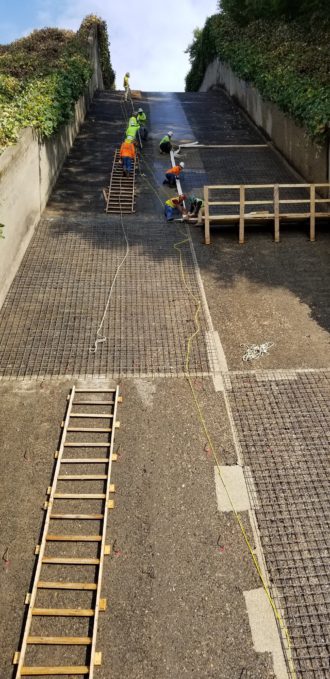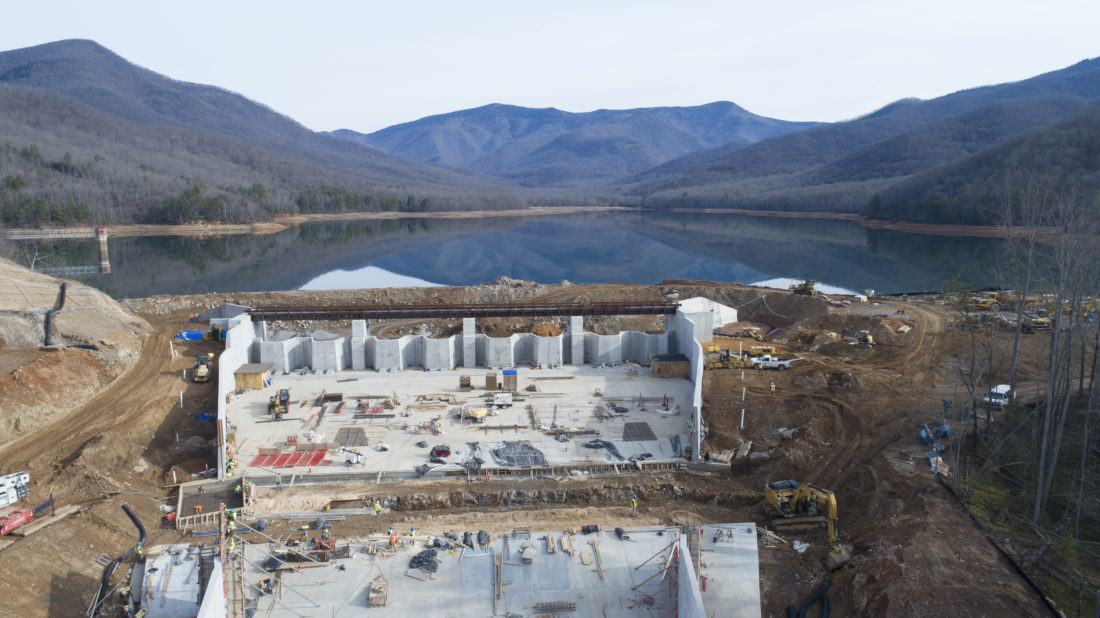Imagine it’s hurricane season 2021. A tropical storm five times wetter than Zeta, which lashed Asheville with at least 3 inches of rain over 48 hours in October, is barreling down on the mountains. Residents throughout Western North Carolina are bringing plants inside, putting away lawn furniture, canceling plans.
What will Leslie Carreiro, who oversees the city of Asheville’s water production and its North Fork Dam in Swannanoa, need to do with such a storm on its way?
“Have a cup of tea,” she says.
Carreiro’s confidence is driven by a $38.5 million, three-year construction project, slated for completion later in November, that brings the North Fork Dam up to North Carolina state standards for safety. The work marks the largest renovation of the dam and its accompanying North Fork Reservoir since the facility’s opening in 1955.
As previously reported by Xpress (see “It’s about dam time,” Sept. 7, 2016), city employees have hitherto managed the water level in the reservoir during big rain events by opening three 18-foot gates in the dam. That practice kept the dam from failing but may have contributed to flooding of the Swannanoa River, which impacts Biltmore Village and other communities.
Instead of manual gates, the dam’s new design uses fixed concrete weirs, over which water flows when the reservoir’s level gets too high. A 4-foot concrete wall around its edge will give the reservoir more capacity to absorb precipitation, while a series of eight fusegates — massive structures built to tip over in flood conditions — will automatically regulate flow into the dam’s spillway under extreme rain.
“I’ll probably have a few less gray hairs and a lot less stress,” Carreiro says. “Thankfully, there’s not a lot we have to do now.”
Carrying water

The North Fork facility provides 70% of Asheville’s water needs, an average of more than 14 million gallons per day. Even that prodigious demand, however, can’t keep up with the supply provided by some big precipitation events.
Such events are becoming increasingly common due to the effects of climate change. According to the N.C. Climate Science Report, an independent review of climate impacts commissioned by the state Department of Environmental Quality, heavy rains from hurricanes and severe thunderstorms will be both stronger and more frequent over the coming decades.
And Carreiro says she’s already noticed a significant change in the region’s weather, with differences becoming more apparent in the last three years. “Before, if we were to get 3 inches of rain, it was over five days, and it was this long slog. Everyone would get kind of grumpy towards the end of the week,” she recalls. “The way I would describe it now is flashiness: You get all this water and then you get nothing.”
Early in planning for the renovations, Carreiro says, Asheville joined a Tennessee Valley Authority study looking at future probable maximum precipitation for the region, which allowed the city to take climate impacts into account. The final design is projected to handle up to 28.4 inches of rain in 24 hours — an event expected to occur, on average, once in 50,000 years.
Ironically, flashy precipitation may have proved more of a challenge to the dam during construction. The project was originally scheduled for completion in late 2019 at a maximum cost of $35 million, but excessive rain in 2018 and early 2020 caused contractors to lose 239 days of work and drove up expenses.
“Especially when you’re moving a lot of earth, when it gets too saturated, you just have to wait until it dries out,” Carreiro says. The project displaced over 368,000 cubic yards of soil and rock, enough to fill the Lincoln Memorial reflecting pool over 11 times.
Made to last
In addition to providing a buffer for climate change, the renovations will help the dam withstand seismic activity, such as the 5.1-magnitude earthquake that hit Sparta in August. While those events are relatively rare in WNC, Carreiro says, they can damage a dam’s integrity, and the original 1955 design didn’t take seismic threats into consideration.
Much of the earth excavated for the new spillway was used to buttress the downstream slope of the dam, Carreiro explains, “just to make sure that we were prepared.” The city also installed automated monitoring equipment to measure vibrations and updated its emergency plans to check for damage after seismic events.
David Melton, the city’s director of water resources, says the overarching philosophy for the renovation was to automate resilience. “Removing that human element also is removing the chance for mistakes,” he explains. Overtime expenses for active management of extreme weather are also expected to decrease.
Despite this automation, no reduction in staff will take place in the Water Resources Department. Instead, Carreiro says employees will be freed up to focus on improvements to the 22,000-acre watershed surrounding the reservoir, a forested valley owned by the city and off-limits to both the public and media.
Asheville, with the help of the N.C. Forest Service, has previously conducted prescribed burns on the property to boost forest health and reduce the chances of severe wildfire. Carreiro also points to a 2014 partnership with Forest Stewards, a nonprofit affiliated with Western Carolina University, that cataloged the watershed’s flora and fauna to inform conservation.
Capital ideas
City staff will now be able to spend more time planning for the next round of capital improvements to the water system. But first, they’ll need to figure out how to pay for it.
In June, Asheville agreed to a legal settlement that discontinued its monthly capital fee for up to five years, a move projected to cost the city as much as $37 million. Melton says the water department continues to work with Charlotte-based Raftelis Financial Consultants on a new rate model to make up the revenue, with a proposal expected by the end of year.
Melton continues that capital spending is relatively low right now because many projects are in the design phase. For the current fiscal year, Asheville has budgeted only $4.92 million on water capital outlay, down from $11.86 million in fiscal 2019-20; in fiscal year 2021-22, Melton adds, the city expects to spend $13 million.
However, it’s unclear how much cash Asheville currently has on hand to support the water system. City officials did not provide details about the water capital fund balance in response to repeated records requests, both in June and October. Melton did indicate that, without additional revenue, projects would begin to be delayed starting in 2023.
While nothing on the scale of the North Fork project is anticipated in the coming years, Carriero and Melton both say that improvements are necessary throughout the system. The city still needs a permanent plan to dispose of water treatment sludge, customer meters must be upgraded, and up to 15 miles of pipe are scheduled for replacement each year.
But for now, Carriero is celebrating the end of a long haul at the dam. “I’ll be popping some sparkling something when it’s done,” she says. “Apple juice or champagne, I haven’t decided.”



A big expression of thanks and appreciation is in order for the work of the Water Department staffers and Capital Project staff for completing this project. Previous city management and councils let this important project languish, IMO.
Now, hopefully we’re on to much needed improvements throughout the city and beyond with regards to the water distribution piping that needs upgrading and replacement.
And while some people aren’t happy about our beer culture in this town, breweries have located here because of our abundant supply of excellent water. Water is a very important resource for our city.
Ix-nay on the ater-way alk-tay! Didn’t you hear Tim Moffitt is back?
400 miles just within the city limits @ $1-1.25mm permiles = don’t hold your breath.
The dam and reservoir are in Black Mountain, not Swannanoa as the story states. The city of Asheville owes us residents of the NorthFork Valley a restored road after years of heavy dump trucks and earth moving equipment have destroyed our only access road.